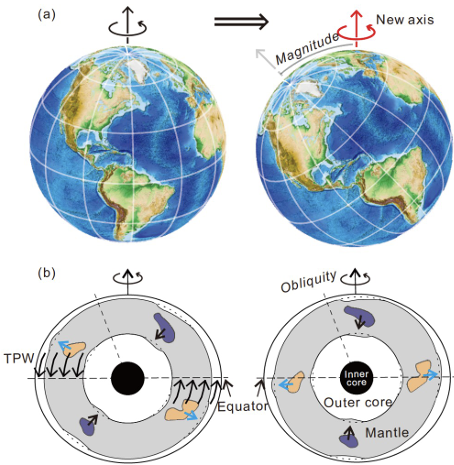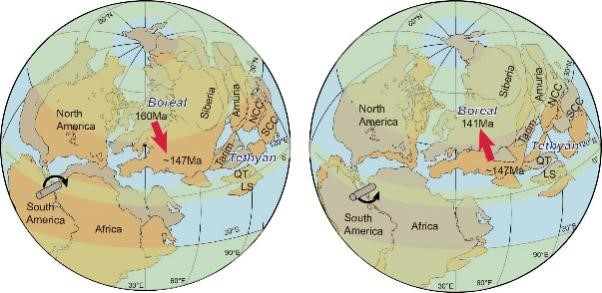True polar wander (TPW) is the reorientation of the entire solid crust mantle shell of a planet with respect to its rotation axis, which can influence the planet’s paleogeography and paleoenvironment. Professor Zhu Rixiang’s laboratory at the Institute of Geology and Geophysics, Chinese Academy of Sciences discovered a large round-trip TPW oscillation that occurred during the Late Jurassic-Early Cretaceous. The researchers suggest that the shifting back-and-forth of the continents may have contributed to the biota evolution in East Asia and global Jurassic-Cretaceous extinction and endemism. The study was published in Nature Communications.
The Mesozoic Era appears to have been an active time interval for TPW, but major uncertainties remain. In particular, there was a debatable TPW of greater than 25° during the Jurassic Period, and its axis of rotation was near the equator in (modern) western Africa (0° N, 11° E). This rotation pattern would have caused great latitudinal movement of the East Asian landmasses, including the North China Craton (NCC), at the far end of the rotation axis. However, there are two models of the TPW: one was a slow and steady continental rotation, which continued throughout the Jurassic, while the other was a rapid rotation between 160 and 145 Ma, also known as the Late Jurassic “monster shift.”
To address these competing models, Postdoc Hou Yifei, under the guidance of Associate Professor Zhao Pan and Professor Zhu Rixiang, acquired both high-resolution geochronologic and high-quality paleomagnetic results from the continuous volcano- and clastic-stratigraphic sequence of the Late Jurassic Tiaojishan Formation and Late Jurassic?Early Cretaceous Tuchengzi Formation in the northern margin of the NCC. The results document a southward shift of approximately 12° in paleolatitude from 155 to 147 Myr ago (~1.5 Myr-1), immediately followed by a roughly 10° northward displacement between 147 and 141 Myr ago (~1.6 Myr-1).
By comparing with the TPW models, the researchers support the existence of the Late Jurassic “monster shift” in East Asia, and propose an underappreciated subsequent return trip that yields a complete round-trip TPW. In addition, the researchers hold that the latitude changes, caused by the round-trip TPW, affected the surface environment, which in turn caused the Late Jurassic?Early Cretaceous extinction and endemism.
The present work was supported by the National Natural Science Foundation of China grants 42288201 (to Zhu Rixiang), Strategic Priority Program (B) of the Chinese Academy of Sciences Grant No. XDB0710000 (to Zhao Pan), National Natural Science Foundation of China grants 92155203 (to Zhao Pan), and National Science Fund for Young Scholars 42102015 (to W.-X.H.).

Figure 1: (a) Sketch of an approximately 45° TPW event if it were to occur today; (b) Cross-section profiles showing forcings from sinking slabs and rising plumes during TPW (image from Wang & Mitchell, 2023).

Figure 2: Late Jurassic–Early Cretaceous TPW round-trip oscillation (image from Hou et al., 2024).
Contact:
Zhao Pan
Institute of Geology and Geophysics, Chinese Academy of Sciences
E-mail: panzhao@mail.iggcas.ac.cn